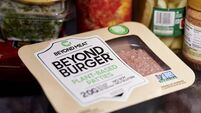Britain faces a 20% rise in food inflation
The bearer of this bad news is Michael Bell, executive director of the Northern Ireland Food and Drink Association.
Mr Bell was talking at the sixth Northern Ireland Food and Drink Outlook Forum in Antrim yesterday.
Its theme was that food inflation is the greatest challenge facing farmers and the food processing industry in the north. This forum is a joint sponsorship involving the Ulster Farmers’ Union and the Northern Ireland Food & Drink Association.
Mr Bell outlined some of his concerns to us before addressing the symposium.
While a 20% inflation rate for this year might be a “worst case scenario” he said a close look at the way the world is evolving makes it clear food inflation is back on the consumer menu.
For 15 years food prices have fallen in real terms until last year when prices started to spiral.
He says consumers in the south could also be hit with 20% inflation this year.
The strength of the euro could give us some protection but overall he believes double-digit food inflation is more or less a given.
If the wheat crop fails in Australia for a third successive year, due to drought, the cost of grain will rise significantly in 2008.
We forget how pervasive grain crops are, he observed. Grain is used in the production of bread and all its offshoots. Every meat category is totally or partially grain fed so the threat of dearer food is spread across all categories. Another problem is it takes 10 times more grain to produce the equivalent of meat protein, which is putting further pressure on grain demand.
Rising living standards are adding to demand in poorer countries for meat and dairy products and as Asia continues to prosper this is a phenomenon that will add to conflicting pressures in the global market for limited grain supplies.
Mr Bell notes one of the key issues in food inflation is the oil factor. Oil has shot up from $23 per barrel since 2003 to close to $100 per barrel due to rising demand and speculation.
That price surge of the last five years has led to a massive surge in biofuel and generated a demand for crops other than grains that are paying much better prices to farmers who have dropped their traditional crop growing in favour of the more lucrative biofuel alternatives.
The growth in world demand, climate change, rising oil prices and the search of oil alternatives, have produced a food price inflation cocktail that is here to stay, according to Mr Bell. Climate change closer to home is also a factor. Flooding wiped out one third of Britain’s pea crop last year.
In that sense, Mr Bell said it was clear there are conflicting demands in the market that will keep pressure on food prices for years.
While prices may spiral this year, he expects we will return to more manageable price rises within a year or two. However, the implications for grain are massive.
Most beers and whiskey products rely on grain for their basis raw material.
The cost implications for most of what we eat and drink are evident.
For that reason, farmers and food processors are all too aware they need to be on their toes to cope with the challenges involved in the delivery of food to consumers in the decades ahead.
It’s a huge challenge and with Europe just 23% self-sufficient in grain the long term implications of the emerging global trends will demand a robust response from all sides engaged in food production.
Recently, an executive within NTR, which is heavily engaged in biofuel activities in the US, denied any link between rising grain prices and the surge in biofuel output — we may have some catching up to do.













